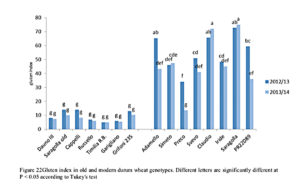Light why?
The scientific community has long highlighted the presence, increasingly accentuated, of a syndrome attributable to the consumption of products containing gluten distinct from celiac disease. The non-celiac gluten sensitivity, even if it regards a small percentage of the population, is in continuous progression and, in any case, concerns a segment that is no longer negligible. It is necessary to reconsider the use, in these cases, of grains with a less tenacious gluten, more digestible that is more tolerable even in cases of gastro-intestinal inflammation. Many scientific researches on ID331 single-grain wheat hope (for example) to use this grain to increase the prevention of celiac disease.
m>”Although noticeably less harmful, the monococco is not however suitable for patients who have already manifested celiac disease,” Gianfrani points out. “Instead, he may have good effects on the development of the disease in subjects at high risk of celiac disease. In fact, since there is a close correlation between the amount of gluten taken and the threshold to trigger the adverse reaction, a preventive action could be to use grains with lower gluten content. Therefore a grain like the monococco that contains a more digestible gluten, and therefore less harmful, could be a valid tool for the prevention of this pathology ”. According to the researchers, even those with gluten sensitivity would welcome a diet based on small spelled. “Today we know that foods made from monococcum wheat are well tolerated even by those who are a part of this eating disorder, which has characteristics different from celiac disease. Therefore, the next step in the research will be to perform the experiments directly on the intolerant subjects to confirm the lower toxicity of the monococcus and bring back to our table an ancient grain “, the researchers conclude. (ISA-CNR and IBP-CNR researchers have shown that small spelled contains a more digestible gluten than common wheat and may be suitable for people sensitive to this substance. The study is published in Molecular Nutrition and Food Research and opens new celiac disease prevention prospects.)”
The first glance goes to the ancient grains (the site clarifies the ancient term or, better, neither from a generally shared interpretation); some ancient grains obviously, since even here there are marked differences. The research focuses on those varieties with a much lighter gluten than (generally) modern grains (figure 22); grains often linked, if not always, to their territory of origin, grains that enhance the territory and also preserve genetic variability. The “modern” grains (briefly those on which Man has laid his hands with specific techniques) are certainly not “ad excludendum” but will be the subject of a later moment.
Cereals (and among these the grains) have a fundamental role in human nutrition and are at the base of the Mediterranean diet because they are the main source of carbohydrates, they provide fiber, B vitamins, mineral salts such as potassium, iron, phosphorus and calcium. The content of vitamins and minerals is greater in the case in which the grain is used in its “In the first decades of the 20th century, the Italian government strongly supported the research so much that in 1925 the project Battaglia del Grano was launched with the aim of making the nation self-sufficient in the production of wheat, without subtracting new land to other crops useful for national economy. The intense programs of genetic improvement carried out after the Second World War, led to the complete substitution of local varieties with new cultivars of reduced size and highly productive with a consequent decrease in the genetic variability of wheat “. (From: Morphological and agronomic characterization of ancient cereal populations Project: Ancient Fruits for new bread – NUTRIGRAN-BIO Project financed with funds from the Rural Development Plan for Umbria 2007-2013). Finally, in the last decades, the progressive industrial transformation concerning the production of bread and derivatives as well as pasta has pushed research towards the creation of varieties with a more tenacious gluten suitable for working with machines. The ancient varieties generally have a gluten not suitable for processing with the machines because they are not very extensible and with reduced stability to the kneading (the kneading time of the ancient varieties can be of few minutes while for the machines it takes much longer times). Modern varieties, not all, meet these needs.
It should be noted immediately, however, what is meant by ancient grains: The ancient term is improper and is used above all in communication, that is quick and concise but, often, misleading. The true differentiation must be made between existing varieties in the past and the object of mass or genealogical selection by man and those obtained by hybridization or genetic modification. These latter varieties are generally the result of different genetic improvement able to respond to different processing methods and different nutritional needs. They will be the subject of studies and research in a subsequent phase. The first varieties include – full-fledged – local or autochthonous varieties. Citing Dr. Ssa Porfiri: “Ancora oggi esistono in Italia varietà locali di Triticum. Solo per citarne qualcuna fra le più conosciute: il farro di Monteleone di Spoleto e il farro della Garfagnana nel dicocco; i frumenti teneri “Solina d’Abruzzo” e “Rosciole” dell’Appennino Centrale; Ruscìe, Saragolla/Saragolle, Marzuolo/Marzuoli nei frumenti duri. E perché al plurale? Perché le varietà locali, similmente alle popolazioni naturali, sono frutto dell’azione combinata di mutazioni, ricombinazioni, fenomeni di migrazione e deriva genetica, selezione e sono popolazioni bilanciate, in equilibrio con un determinato ambiente, geneticamente dinamiche, ma anche soggette a diversi gradi di selezione attuata dagli agricoltori. Pertanto, grazie alla loro variabilità
all’adattamento a
assumono tratti
differenziati, tali da consentire una diversa identità genetica in ogni ambiente.”

Deepening:
1) Concept of species, variety
2) Morphological and agronomic characterization of ancient cereal populations

